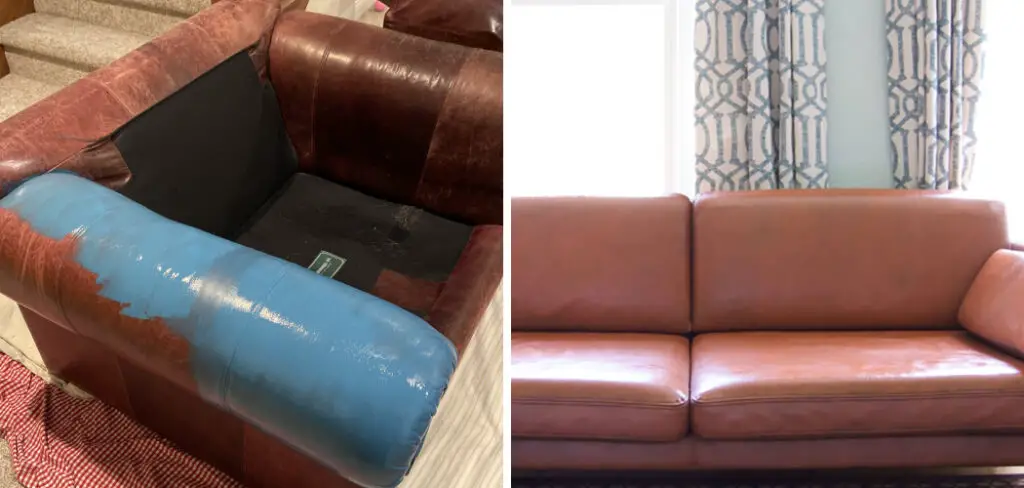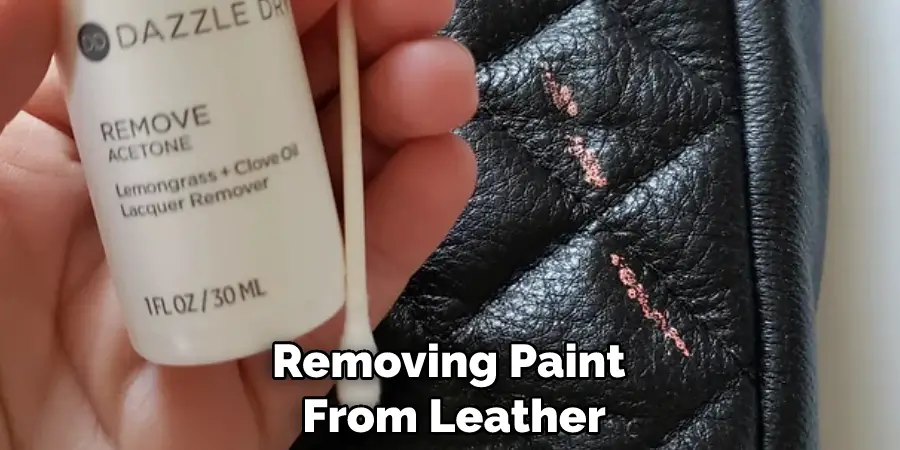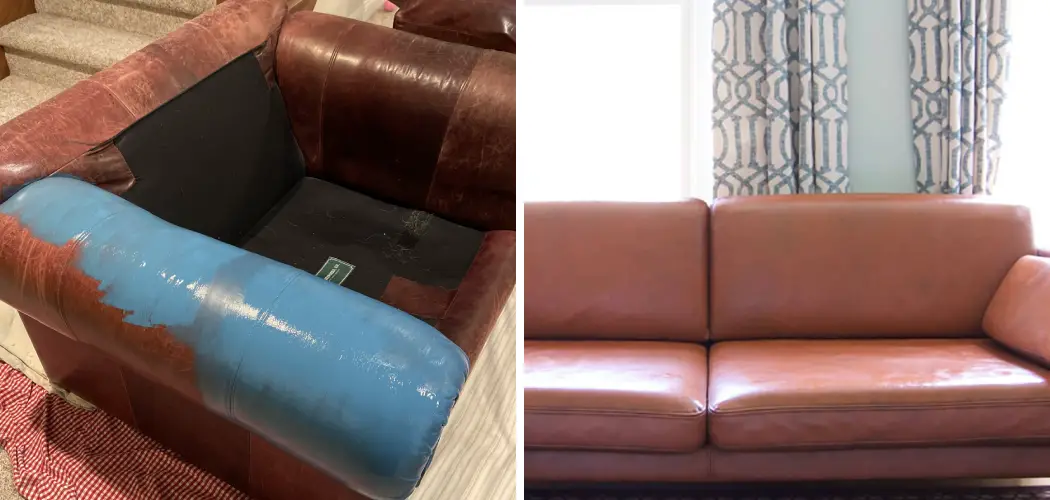When you’re moving and have to quickly clean your old leather couch before the new owners come to pick it up, you realize just how difficult it is to get paint off leather. It seems like every time you think you’ve gotten it all off, another spot pops up. So, what’s the best way to remove paint from a leather couch? And, more importantly, will the paint ruin the leather?

If you’ve ever tried to get paint off of a leather couch, you know it can be a real challenge. The good news is that you can do a few things to make the job easier.
In this blog post, we’ll share tips on how to get paint off leather couch quickly and easily. Keep reading for more information!
Can Paint Ruin the Leather?
One of the first things to consider when removing paint from leather is how much damage it could cause. While many types of paints can be corrosive and hazardous to the leather, latex paint may not have as big of an impact on your couch’s surface.
To determine how safe it will be to clean off that paint, start by testing a small spot with mild soap and water first. If any negative reactions, such as discoloration or mold spots, form, you’ll need to take extra care in removing the paint.

What Will You Need?
When it comes to removing paint from leather, you’ll want to have a few tools and cleaning agents on hand. These include:
- Mild soap and water
- Rubbing alcohol or nail polish remover
- Soft clothes or sponges
- A small bowl for mixing the cleaning agent with water
- Cleaning gloves to protect your hands from the chemicals
With these tools, you can begin to safely and effectively clean off that paint from your couch.
10 Easy Steps on How to Get Paint Off Leather Couch
Step 1. Wash the Affected Area:
Start by thoroughly washing the area with mild soap and water to remove as much of the paint as possible. Be sure to use a soft sponge or cloth to avoid damaging the leather. If you notice any discoloration or damage to the surface, move on to step 2.
Step 2. Apply a Mild Cleaning Agent:
If you notice any discoloration or damage to the leather after washing with water and soap, apply a small amount of rubbing alcohol or nail polish remover. Use a soft cloth and gently rub it into the affected area. It’s important to be careful not to soak the leather or apply too much pressure, as this can damage your couch.
Step 3. Rinse and Dry:
Once you’ve removed all of the paint from the leather, rinse it thoroughly with water to remove any traces of the cleaning agent. Use paper towels or a soft cloth to dry the area completely before moving on. If you notice any streaks or discoloration, repeat steps 1-3 until you’re satisfied with the results.
Step 4. Condition Leather:
After cleaning off the paint from your leather couch, it’s important to condition and protects the surface to prevent future scratches or discoloration. Consider using a commercial-grade leather conditioning product designed for use on furniture. Or simply use a small amount of olive oil or coconut oil on a soft cloth to gently rub into the leather.
Step 5. Use Leather Repair Kit:
If the paint has caused any lasting damage to your couch, consider using a leather repair kit to fix small tears or scratches on the surface. This can help prevent further discoloration that can occur if you leave those imperfections untreated. Be careful to follow the instructions that come with your repair kit, as the improper application can lead to further damage.

Step 6. Keep Your Leather Clean Regularly:
Whether your couch is freshly painted or was previously affected by another stain, it’s important to keep it clean regularly with mild soap and water or a similar cleaning agent designed for use on leather surfaces. This will help prevent dirt and grime from building up over time and causing further damage to your couch’s surface.
Step 7. Use Covers:
To protect your leather couch from future paint spills or stains, consider using furniture covers to cover the surface while painting or for other messy activities. This can help prevent accidental spills and make it easier to clean up any messes. If you don’t have furniture covers available, be sure to use drop cloths or other protective coverings to prevent damage.
Step 8. Invest in Leather Cleaning Products:
If you have many items made of leather in your home, investing in a few commercial-grade leather cleaning products can be a great way to keep them looking new for years to come. Look for products designed specifically for use on furniture. And follow the instructions carefully to get optimal results.
Step 9. Consult with a Professional:
If you’re unsure how to get paint off a leather couch safely and effectively, consider consulting with a professional leather cleaner or an expert in leather care. They can provide you with tailored advice and tips to help keep your leather looking great for years to come. Moreover, they’ll be able to address any underlying damage that may have occurred.
Step 10. Stay Patient:
Finally, when it comes to removing paint from leather, be sure to stay patient and take your time throughout the process. This will help prevent any damage or staining that can occur if you rush through the cleaning process or apply too much pressure to the surface of your couch.
Following these steps should help keep your leather looking great for years to come!

5 Additional Tips and Tricks
1. Use a soft, damp cloth or a clean sponge to remove any excess paint from your leather couch gently.
2. If the paint stain is oil-based, you may find that it can be removed with a mixture of dry cleaning solvent and water. Mix these two ingredients together in equal parts, and apply to the stained area with a clean rag or sponge.
3. If you are dealing with water-based paint stains, try using rubbing alcohol to help break down the stain. Apply a small amount of rubbing alcohol to a clean rag or sponge and gently wipe over the paint until it is removed.
4. Blot the stain with a dry cloth to help absorb any excess moisture from your leather couch before proceeding with further cleaning measures.
5. If these methods do not work, apply a vaseline-based product over the paint stain and let it sit for several hours. The petroleum jelly will help loosen the paint, making it easier to remove.
These additional tips and tricks should help you effectively remove paint stains from your leather couch. With a bit of patience and care, you can restore your couch to its original beauty in no time!
5 Things You Should Avoid
- Using harsh or abrasive chemicals to scrub the paint off.
- Using acetone, alcohol, or other solvents to try to remove the paint. These substances can damage your leather and cause irreversible staining.
- Exposing your leather to direct heat or sunlight in an attempt to dry it out faster. This can cause discoloration and crack of the material over time.
- Trying to treat your leather yourself without first consulting a professional leather upholstery cleaner or restorer. They will be able to assess the damage and determine how best to clean and restore your sofa without causing further damage.
- Try DIY techniques that you find online before doing some research on reputable sources with proven methods. There are many different options, but choosing the ones best suited for your particular leather material and how much paint has been applied is important.
Taking precautions and avoiding these common mistakes will help ensure that your leather couch stays looking its best for years to come. Good luck!
Does Magic Eraser Remove Paint From Leather?
The quick answer is no – magic erasers are typically designed to clean hard surfaces like wood and metal and are ineffective at removing paint from leather.
Additionally, using harsh or abrasive chemicals to scrub the paint off may also damage your leather, and attempting to treat your leather yourself without first consulting a professional can lead to further damage.

Suppose you are dealing with water-based paint stains or other types of stubborn stains on your leather couch. In that case, it is best to consult a professional leather cleaner or restorer who can assess the damage and provide tailored advice and tips for removing paint from leather.
Frequently Asked Questions
Can Paint Come Off Leather?
Leather is a durable material that can last many years without having to be replaced. That being said, there are some things that can damage leather and cause it to wear more quickly. One of these things is paint. Paint can chemically react with the natural oils in leather and cause the paint to come off in large flakes. This can lead to the leather becoming dry and brittle, which makes it susceptible to tears and other damage.
What Removes Dried Paint?
There are a number of ways to remove dried paint, depending on the severity of the stain and the type of paint involved. Some of the most common methods include:
1. Scrubbing with a scrub brush: This method is effective when dried paint is stubborn or embedded in the surface.
2. Blasting with a garden hose: This method is suitable for removing dried paint from areas that are difficult to access, such as around windows or inside corners.
3. Sanding: Dried paint can be sanded off using a coarse sandpaper to expose the underlying surface.
4. Wiping down with a wet cloth: This method is useful for removing dried paint from small areas or delicate objects.
5. Using a degreaser: A degreaser can be used to break down dried paint and remove it completely.
Does Paint Thinner Damage Leather?
The effects of paint thinner on leather depend on the type of paint thinner, the quality of the leather, and the amount of paint thinner used. In general, it is possible for paint thinner to damage leather if it is applied too thinly or if it is left on the surface too long. However, there is no evidence to support the claim that using a thicker coat of paint or waiting longer before cleaning the Leather will protect it from damage. In fact, excessive use of paint thinner may actually lead to more damage because it can strip away the protective layer of oil that protects leather from wear and tear. Ultimately, it is important to use caution when using paint thinner and to test a small area first before applying it to an entire piece of leather.
Is There a Safe Paint Remover?
The best paint remover for a particular job may vary depending on the type of paint and the condition of the surface. However, some general tips to keep in mind when using a paint remover include:
1. Always test the product on a small area first to make sure it is safe and effective for use.
2. Use a moderate amount of the remover, taking care not to overspray or flood the area.
3. Allow the remover to work its magic for a few minutes before trying to remove any excess residue using a cloth or a brush.
4. Rinse the area thoroughly with clean water after removing the residue, and dry it off completely before applying any new paint.
Conclusion
All in all, it is not as difficult as you might think to get paint off a leather couch. With a little time and the right tools, you can remove paint from your leather furniture without causing any damage.
In conclusion, the best way to remove paint from a leather couch is by using a delicate cleaner and following the manufacturer’s instructions. Be sure to test the cleaner in an inconspicuous area first, and always err on the side of caution when using any new product on your furniture.
Hopefully, the article on how to get paint off leather couch has been helpful and has given you the tools and tips you need to restore your leather furniture to its original beauty. Good luck!

